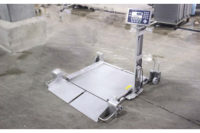New White Paper explains how to improve safety inspection of pumped food lines

A wide range of processed food passes through pipelines everyday, from meat and poultry to dairy products, and fruit and vegetables to confectionery. However, contamination detection in pumped products can prove challenging.
Safeline X-ray's brand-new white paper entitled Improving Food Safety Inspection of Pumped Products explains how metal detection and x-ray pipeline inspection systems work, and points out their differing capabilities, before exploring factors that affect the sensitivity of product inspection equipment on pumped food lines.
With plenty of examples of pumped food applications, the 16 page document goes on to discuss key factors that should be considered before installing an inspection system on a pumped food line, such as air pockets and speed variations, to help manufacturers select the best contamination detection solution for their specific application.
Metal Detection, X-ray Inspection or Both?
The paper reveals that for many pumped products, only metal detection or x-ray inspection will be suitable but that, in some cases, either technology could be used. It also explains that occasions exist where it may be necessary to install metal detection and x-ray inspection equipment at different critical control points (CCPs) on the same production line.
Establishing Critical Control Points
Product inspection systems for piped products can be used at different stages on a production line, depending on the identified CCP, and the paper highlights the advantages of installing x-ray pipeline inspection or metal detection equipment early in the production process. These include allowing manufacturers to recover product and feed it back into the line after contaminant removal, helping to prevent damage to processing equipment caused by larger contaminants, and serving as a check on suppliers’ quality control.
Testing Pipeline Applications
After explaining that all x-ray inspection equipment must be periodically verified to ensure it continues to reject contaminated product and operates in accordance with the specified sensitivity standard, the document provides tips for testing metal detector and x-ray pipeline applications.
To view the white paper, click here.
Looking for a reprint of this article?
From high-res PDFs to custom plaques, order your copy today!




